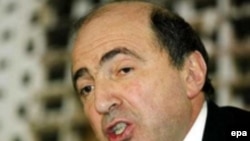Berezovksy, in an interview with the BBC, said he was ready to meet with Russian and British investigators if it would help find out who killed Litvinenko.
Britain has not yet agreed formally to let Russian investigators come to London to pursue leads in the case. British authorities are continuing to investigate the death.
Berezovsky also told the BBC that Litvinenko told him before his death that he suspected that Russian businessman Andrei Lugovoi was involved in his poisoning.
Lugovoi has denied playing any role in Litvinenko's fatal sickness.
Litvinenko died in London last November 23 after being poisoned with the rare radioactive isotope polonium-210.
The London-based Berezovsky was a friend and supporter of Litvinenko. Both men have been critics of Russian President Vladimir Putin's government.
(AP, AFP, BBC)
Facts About Polonium-210
- Polonium, also called "radium F," was discovered by Marie Curie and her husband, Pierre Curie, in 1898 and was later named after Marie's homeland of Poland (Latin: Polonia).
- It is an alpha emitter, meaning that although it is highly radioactive, it cannot penetrate human skin or a sheet of paper. Washing eliminates traces.
- Contact with a carrier's sweat or urine could lead to exposure. But polonium-210 must be ingested or inhaled to cause damage.
- Polonium-210 has a relatively short half-life of 138 days.
- Polonium-210 occurs naturally in the environment (it is found in such things as dirt and tobacco) and in people at low concentrations. But acquiring a lethal amount would require individuals with expertise and connections.
- Polonium-210 emits 5,000 times more alpha particles than radium, and an amount the size of the period at the end of this sentence would contain about 3,400 times the lethal dose. A dose like the one that killed former Russian spy Aleksandr Litvinenko would probably have been manufactured at a nuclear facility.
- Russia exports 8 grams of polonium-210 monthly, all of it to the United States. Exports to Britain ended about five years ago.
